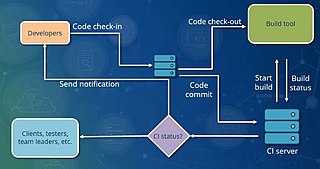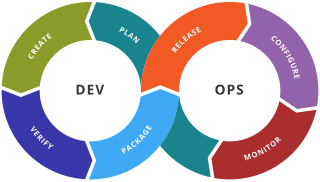
Computer-aided design (CAD) is the use of computers to aid in the creation, modification, analysis, or optimization of a design. This software is used to increase the productivity of the designer, improve the quality of design, improve communications through documentation, and to create a database for manufacturing. Designs made through CAD software help protect products and inventions when used in patent applications. CAD output is often in the form of electronic files for print, machining, or other manufacturing operations. The terms computer-aided drafting (CAD) and computer-aided design and drafting (CADD) are also used.

Configuration management (CM) is a management process for establishing and maintaining consistency of a product's performance, functional, and physical attributes with its requirements, design, and operational information throughout its life. The CM process is widely used by military engineering organizations to manage changes throughout the system lifecycle of complex systems, such as weapon systems, military vehicles, and information systems. Outside the military, the CM process is also used with IT service management as defined by ITIL, and with other domain models in the civil engineering and other industrial engineering segments such as roads, bridges, canals, dams, and buildings.
The rational unified process (RUP) is an iterative software development process framework created by the Rational Software Corporation, a division of IBM since 2003. RUP is not a single concrete prescriptive process, but rather an adaptable process framework, intended to be tailored by the development organizations and software project teams that will select the elements of the process that are appropriate for their needs. RUP is a specific implementation of the Unified Process.
A modeling language is any artificial language that can be used to express data, information or knowledge or systems in a structure that is defined by a consistent set of rules. The rules are used for interpretation of the meaning of components in the structure of a programming language.

The history of software configuration management (SCM) can be traced back as early as the 1950s, when CM, originally for hardware development and production control, was being applied to software development. Early software had a physical footprint, such as cards, tapes, and other media. The first software configuration management was a manual operation. With the advances in language and complexity, software engineering, involving configuration management and other methods, became a major concern due to issues like schedule, budget, and quality. Practical lessons, over the years, had led to the definition, and establishment, of procedures and tools. Eventually, the tools became systems to manage software changes. Industry-wide practices were offered as solutions, either in an open or proprietary manner. With the growing use of computers, systems emerged that handled a broader scope, including requirements management, design alternatives, quality control, and more; later tools followed the guidelines of organizations, such as the Capability Maturity Model of the Software Engineering Institute.

In systems engineering, information systems and software engineering, the systems development life cycle (SDLC), also referred to as the application development life cycle, is a process for planning, creating, testing, and deploying an information system. The SDLC concept applies to a range of hardware and software configurations, as a system can be composed of hardware only, software only, or a combination of both. There are usually six stages in this cycle: requirement analysis, design, development and testing, implementation, documentation, and evaluation.

In industry, product lifecycle management (PLM) is the process of managing the entire lifecycle of a product from its inception through the engineering, design and manufacture, as well as the service and disposal of manufactured products. PLM integrates people, data, processes, and business systems and provides a product information backbone for companies and their extended enterprises.
Product data management (PDM) is the name of a business function within product lifecycle management (PLM) that denotes the management and publication of product data. In software engineering, this is known as version control. The goals of product data management include ensuring all stakeholders share a common understanding, that confusion during the execution of the processes is minimized, and that the highest standards of quality controls are maintained. PDM should not be confused with product information management (PIM).
In the context of software engineering, software quality refers to two related but distinct notions:
In configuration management, a baseline is an agreed description of the attributes of a product, at a point in time, which serves as a basis for defining change. A change is a movement from this baseline state to a next state. The identification of significant changes from the baseline state is the central purpose of baseline identification.

Continuous integration (CI) is the practice of integrating source code changes frequently and ensuring that the integrated codebase is in a workable state.
Integrated logistics support (ILS) is a technology in the system engineering to lower a product life cycle cost and decrease demand for logistics by the maintenance system optimization to ease the product support. Although originally developed for military purposes, it is also widely used in commercial customer service organisations.
Microsoft Visual SourceSafe (VSS) is a discontinued source control program oriented towards small software development projects. Like most source control systems, SourceSafe creates a virtual library of computer files. While most commonly used for source code, SourceSafe can handle any type of file in its database, but older versions were shown to be unstable when used to store large amounts of non-textual data, such as images and compiled executables.
Software project management is the process of planning and leading software projects. It is a sub-discipline of project management in which software projects are planned, implemented, monitored and controlled.
The following outline is provided as an overview of and topical guide to technology:
Build automation is the practice of building software systems in a relatively unattended fashion. The build is configured to run with minimized or no software developer interaction and without using a developer's personal computer. Build automation encompasses the act of configuring the build system as well the resulting system itself.
AnthillPro is a software tool originally developed and released as one of the first continuous integration servers. AnthillPro automates the process of building code into software projects and testing it to verify that project quality has been maintained. Software developers are able to identify bugs and errors earlier by using AnthillPro to track, collate, and test changes in real time to a collectively maintained body of computer code.

A definitive media library is a secure information technology repository in which an organisation's definitive, authorised versions of software media are stored and protected. Before an organisation releases any new or changed application software into its operational environment, any such software should be fully tested and quality assured. The definitive media library provides the storage area for software objects ready for deployment and should only contain master copies of controlled software media configuration items (CIs) that have passed appropriate quality assurance checks, typically including both procured and bespoke application and gold build source code and executables. In the context of the ITIL best practice framework, the term definitive media library supersedes the term definitive software library referred to prior to version ITIL v3.
Bill Curtis is a software engineer best known for leading the development of the Capability Maturity Model and the People CMM in the Software Engineering Institute at Carnegie Mellon University, and for championing the spread of software process improvement and software measurement globally. In 2007 he was elected a Fellow of the Institute of Electrical and Electronics Engineers (IEEE) for his contributions to software process improvement and measurement. He was named to the 2022 class of ACM Fellows, "for contributions to software process, software measurement, and human factors in software engineering".

A DevOps toolchain is a set or combination of tools that aid in the delivery, development, and management of software applications throughout the systems development life cycle, as coordinated by an organisation that uses DevOps practices.







